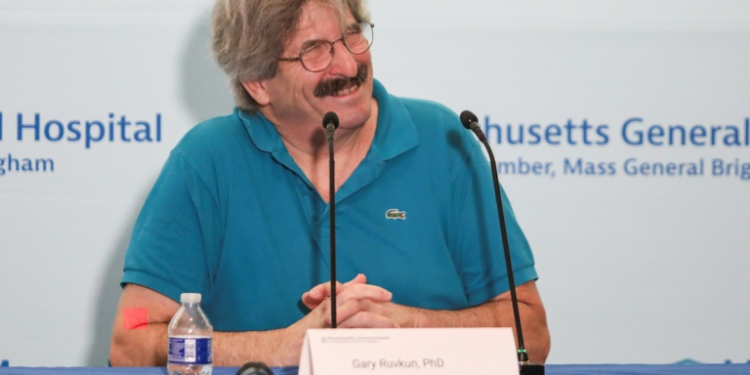Boston (AFP) – Harvard geneticist Gary Ruvkun vividly remembers the late-night phone call with his longtime friend and now 2024 Nobel Prize in Medicine co-laureate Victor Ambros, when they made their groundbreaking discovery of genetic switches that exist across the tree of life. It was the early 1990s. The pair, who had met a decade earlier and bonded over their fascination with an obscure species of roundworm, were exchanging datapoints at 11 pm — one of the rare moments Ambros could steal away from tending to his newborn baby.
“It just fit together like puzzle pieces,” Ruvkun told AFP in an interview from his home in a Boston suburb, shortly after learning of the award on Monday. “It was a eureka moment.” What they had uncovered was microRNA: tiny genetic molecules that act as key regulators of development in animals and plants, and hold the promise of breakthroughs in treating a wide range of diseases in the years ahead. Although these molecules are only 22 “letters” long — compared to the thousands of lines of code in regular protein-coding genes — their small size belies their critical role as molecular gatekeepers. “They turn off target genes,” Ruvkun explained.
“It’s a little bit like how astronomy starts with looking at the visible spectrum, and then people thought ‘If we look with X rays, we can see much higher energy events,'” he added. “We were looking at genetics at much smaller scales than it had been looked at before.”
– Dismissed at first –
Their discovery had its roots in early investigations into C. elegans, a one-millimeter-long roundworm. Ambros and Ruvkun were intrigued by the interplay between two genes that seemed to disrupt the worm’s normal development — causing them either to stay in a juvenile state or acquire adult features prematurely. The genetic information contained in all our cells flows from DNA to messenger RNA (mRNA) through a process called transcription, and then on to the cellular machinery where it provides instructions on which proteins to create.
It’s through this process, understood since the mid-20th century, that cells become specialized and carry out different functions. But Ambros and Ruvkun, who began their work in the same lab before moving to different institutions, discovered a fundamentally new pathway for regulating gene activity through microRNAs, which control gene expression after transcription. They published their findings in back-to-back papers in Cell in 1993, but at first, the discovery was dismissed as an esoteric detail, likely irrelevant to mammals. “We were considered an oddity in the world of developmental biology,” Ruvkun recalled. Even he had little idea their work would one day be celebrated by the wider scientific community.
That all changed in 2000 when Ruvkun’s lab discovered another microRNA that was present throughout the tree of life — from roundworms to mollusks, chickens, and humans.
– ‘Celebrating like crazy’ –
At the time, the human genome was still being mapped, but the portion that was complete was available to researchers. “I think it was probably one-third done, and I could already see (the new microRNA) in that one-third of the human genome,” said Ruvkun. “That was a surprise!” Since then, the microRNA field has exploded, with more than 170,000 citations currently listed in biomedical literature. More than 1,000 microRNAs have been identified in human DNA, and some are already being used to better understand tumor types and develop treatments for people with chronic lymphocytic leukemia. Trials are also underway to develop microRNAs as treatments for heart disease.
On the morning of their Nobel win, the two old friends “Facetimed and high-fived,” Ruvkun said. “It’s magnificent, and we’re going to be celebrating like crazy.”
© 2024 AFP











